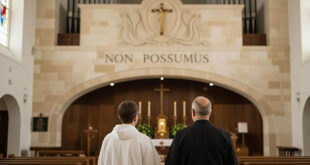Lectio Divina, or “Divine Reading,” is an ancient prayer and meditation practice that invites us to immerse ourselves in God’s Word in a profound, personal, and transformative way. In today’s fast-paced world, where our connection to the sacred is often threatened by noise and distraction, Lectio Divina offers us a space for recollection, active listening, and dialogue with God through Scripture. This method is not just another way to read the Bible; it’s an experience that can transform our relationship with faith, our view of life, and our connection with the Creator.
In this article, we’ll explore the historical foundations of Lectio Divina, its theological structure, and how to practice it in our daily lives. We’ll go over each stage of this method, so you can gradually experience the comfort, peace, and wisdom that God wants to communicate to you through His Word.
Origins and Meaning of Lectio Divina
The practice of Lectio Divina traces its origins back to the early centuries of Christianity. The desert monks and early Church Fathers were pioneers in seeking ways to approach God by meditating on Scripture. But it was St. Benedict of Nursia, founder of Western monasticism, who formalized the practice in the sixth century in his Rule for Monks, indicating that the reading of Scripture should be slow, meditative, and, above all, directed towards internalization and spiritual growth. In the Middle Ages, thanks to figures like St. Gregory the Great and St. Bernard of Clairvaux, Lectio Divina became central to monastic life.
In the 12th century, the Carthusian monk Guido II established the four stages that structure this spiritual practice: lectio (reading), meditatio (meditation), oratio (prayer), and contemplatio (contemplation). These stages are not just steps to follow, but a process for God’s Word to permeate our minds and hearts, leading our faith from intellectual understanding to spiritual experience.
Today, the Catholic Church continues to promote Lectio Divina, not only for monks or religious people, but for all the faithful. Pope Benedict XVI, in his encyclical Verbum Domini, encouraged Christians to practice Lectio Divina as a way to revitalize our faith and foster a personal relationship with Christ. Although an ancient practice, it takes on new relevance in the modern context, helping us to disconnect from the daily rush and center our minds and hearts on the divine message.
The Four Stages of Lectio Divina: A Path of Listening and Encounter
- Lectio (Reading): “Listen attentively”In this first stage, we open the Bible and read a specific passage. It may be a segment from the Gospel, a parable, or any text that resonates in our hearts. The key here is to read slowly, without rushing, allowing each word to settle within us. This is not the time for theological analysis or interpretation; it is a deep listening, with an open heart to receive the message that God wants to reveal to us.It can be helpful to read the text quietly, even multiple times, so that the words begin to echo within us. You might say an opening prayer, asking the Holy Spirit to enlighten you and help you grasp the deeper meaning of the text.
- Meditatio (Meditation): “Let the Word penetrate you”After reading the passage, we move on to meditation. This is the stage where we reflect on what we have read and seek to understand how that message applies to our lives. Here, we ask ourselves: “What is God saying to me through this passage? What significance does this word have for me today?”Meditation is not simply an intellectual reflection; it is a dialogue with God, an openness to His message. For instance, if we are reading the Gospel of Matthew, where Jesus says, “Come to me, all you who are weary and burdened,” we can ask ourselves, “In what areas of my life do I feel burdened? How can I draw closer to Christ to find relief?”
- Oratio (Prayer): “Respond to God with your heart”The oratio stage is our response to God. Here, we express our feelings, emotions, and thoughts in the form of prayer. This prayer can be one of praise, supplication, gratitude, or even repentance. Prayer in Lectio Divina is a sincere conversation with God, in which we open our hearts to Him and allow Him into our lives.We don’t need to be eloquent or use complex words. We can simply share with Him our joys, concerns, or desires, and let Him work within us.
- Contemplatio (Contemplation): “Rest in the presence of God”Finally, we come to the stage of contemplation. Here, after having read, meditated, and prayed, we enter a deep silence and a state of stillness in the presence of God. Contemplation is the moment when we stop talking and listen in silence, allowing God to speak to us through His peace and presence.This is perhaps the most challenging stage in today’s world, where we are accustomed to action and quick results. However, by practicing contemplation, we allow God’s Word to take root deep within us, transforming us in a quiet and lasting way.
Practical Applications of Lectio Divina in Daily Life
Lectio Divina might initially seem like a practice suited to monks or people with lots of time for prayer. However, it is an accessible and adaptable discipline for the daily lives of any Christian, regardless of circumstances or commitments. Here are some tips to incorporate this practice into your routine:
- Set aside daily time for Lectio Divina: Even if you only have ten minutes, choose a time of day to dedicate to this practice. It can be in the morning, to start the day with God’s Word in your heart, or at the end of the day, to find peace before resting.
- Create a sacred space in your home: Dedicate a small corner in your home for this moment of prayer. You can place a Bible, a candle, or a sacred image that inspires you and helps you focus on God.
- Keep a spiritual journal: During your Lectio Divina, write down any reflections, thoughts, or feelings that arise. Over time, this record will become a tool to see how God’s Word acts in your life and guides your faith journey.
- Share Lectio Divina with family or in community: If possible, gather your family or a group of friends to practice Lectio Divina together. Sharing reflections and prayers with others can enrich the experience and strengthen spiritual bonds.
Lectio Divina in the Modern World: A Response to the Need for Deep Connection
In today’s world, where we often feel fragmented and disconnected, Lectio Divina offers a way to root ourselves in the essential. It invites us to pause, disconnect from the noise, and tune in to God’s voice speaking to us through His Word. Far from being a monotonous ritual, this practice allows us to approach Scripture in a living and dynamic way, experiencing each day the presence of a God who wants to speak to our hearts and guide our steps.
In the end, Lectio Divina is a path of love, where we discover a God who is near, who loves us, who listens to us, and who invites us to respond to His love with generosity. By practicing it, we open our hearts to a transformative encounter that not only enriches our spiritual life, but also helps us live in greater fullness and peace.
I encourage you to start today! Through this practice, may you find comfort, hope, and a renewed connection with God that illuminates every corner of your life.






